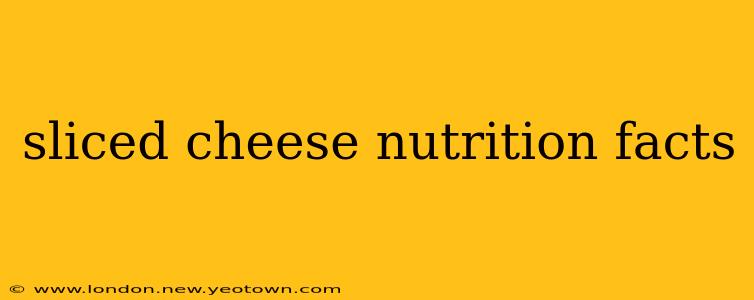Let's be honest, sliced cheese is a staple. From quick grilled cheese sandwiches to topping your favorite burger, its convenience and meltability make it a pantry essential. But how much do we really know about what's in that seemingly simple slice? This isn't just about calories; it's about understanding the nutritional profile of a food we consume so frequently. Let's unravel the mysteries of sliced cheese nutrition facts, one slice at a time.
What are the nutritional values in a slice of cheese?
This is the million-dollar question, isn't it? The answer, unfortunately, isn't a single number. The nutritional content of a slice of cheese varies wildly depending on the type of cheese, the brand, and even the specific slice itself. A single slice of cheddar will have a different nutritional profile than a slice of provolone, and variations within those types are common. However, we can establish some general guidelines. A typical slice (around 1 ounce) often contains:
- Calories: Around 70-100 calories.
- Fat: Between 5-8 grams, a significant portion of which is saturated fat.
- Protein: Around 6-8 grams, making it a decent source of protein.
- Sodium: This is where things can get interesting. Sodium content can range drastically, from around 150mg to well over 200mg per slice, depending on the brand and type of cheese.
- Calcium: Cheese is a good source of calcium, usually providing around 10-15% of your daily recommended intake per slice.
How many calories are in a slice of American cheese?
American cheese, that ubiquitous processed cheese, often sits on the lower end of the calorie spectrum. A single slice usually contains around 70-80 calories. However, it's crucial to remember that processed cheese often contains additives and preservatives that may impact its nutritional value compared to natural cheese.
How many carbs are in a slice of cheese?
The carbohydrate content in cheese is generally very low. Most slices contain less than 1 gram of carbohydrates, making it a suitable choice for those following low-carb diets. However, always check the nutrition label of the specific brand and type you're consuming as minor variations exist.
What are the benefits of eating cheese?
Beyond its convenience and delicious flavor, cheese offers several health benefits:
- Good source of calcium: Essential for strong bones and teeth.
- Provides protein: Contributes to muscle building and repair.
- Contains beneficial fats: While it's important to be mindful of saturated fat intake, cheese also contains some healthy fats.
- Rich in vitamins and minerals: Depending on the type of cheese, you can obtain various vitamins and minerals like vitamin A, vitamin B12, and zinc.
What are the downsides of eating cheese?
While cheese offers many benefits, it's important to be aware of potential downsides:
- High in saturated fat: Excessive saturated fat consumption can contribute to heart disease. Moderation is key.
- High in sodium: Too much sodium can raise blood pressure. Choosing lower-sodium options can mitigate this risk.
- May be high in calories: While not excessively calorie-dense, frequent consumption of cheese can contribute to weight gain if not balanced with a healthy diet and lifestyle.
- Lactose intolerance: Some individuals may experience digestive discomfort due to lactose intolerance.
Is it better to eat a block of cheese or sliced cheese?
Nutritionally, there's very little difference between a block of cheese and pre-sliced cheese. However, pre-sliced cheese often contains added preservatives and emulsifiers to enhance its shelf life and texture. Some people prefer the convenience and portion control of sliced cheese, while others prefer the freshness and slightly better nutritional profile of a block of cheese.
Ultimately, the best choice depends on your personal preferences and priorities. Reading the nutrition labels and selecting brands that align with your dietary needs is crucial, regardless of whether you opt for a block or pre-sliced cheese.
This journey through sliced cheese nutrition facts reveals that this humble food isn't as simple as it seems. While convenient and delicious, mindful consumption, paying attention to portion sizes and selecting lower sodium options, is key to enjoying its benefits while mitigating potential drawbacks. Always check the nutrition label for the most accurate information regarding your specific brand and type of sliced cheese.

